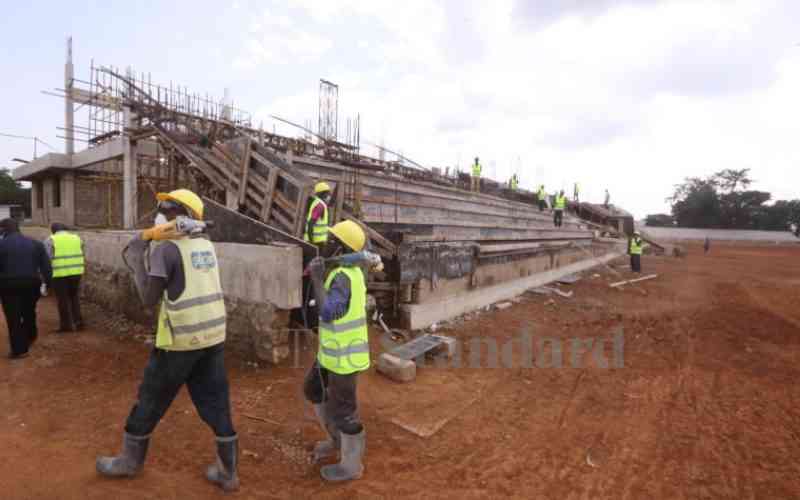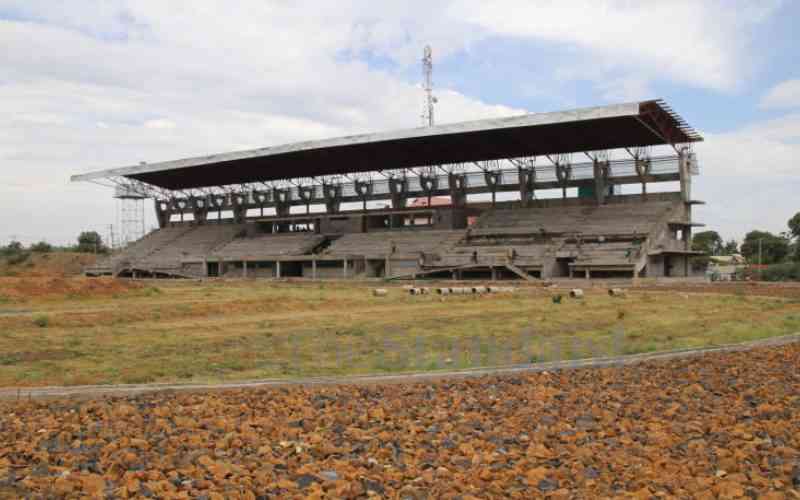
For the past five decades since Kenya attained independence, Nyanza has been at the fore of producing some of the best football players in the country.
Some of these successful players went on to dominate both for their local clubs and the national team, Harambee Stars.
From the likes of Allan Thigo, Peter Dawo, and Dennis Oliech to Kenneth Muguna and Michael Olunga, the region has consistently furnishing the national team with top-tier players.
However, the story of football stadiums across Nyanza is different. Despite its rich talent, Nyanza region does not have standardised sports facilities to support its players.
Since sports became a devolved function controlled at the county level, there has been a rise in the number of stadia and sports infrastructure.
However, construction of the said infrastructure has been going at a snail's pace, hindering sports activities in the process.
Starting from Kisumu county to Siaya, Homa Bay, Nyamira and Migori counties, there is no single stadium that can host either regional or international matches. At one point, it was difficult to stage even local matches as most of the stadia were under construction or renovation.
The first is Moi Stadium in Kisumu, which for more than a decade prior to 2009 had been abandoned.
That was until FIFA, the international governing body of football, agreed to upgrade the facility in 2012 including the provision of artificial turf and renovated terraces.
FIFA did its part and the county government was left to finish the construction, with promises that it would be a world-class stadium capable of hosting local and regional tournaments alike.
However, after completion, the stadium is below par. So bad is the state of the stadium that Kisumu lost a chance to host the 2013 CECAFA games owing to poor infrastructure and health concerns. There was in fact a dumpsite sitting right next to the stadium's perimeter wall.
Eventually, the Ethics and Anti-Corruption Commission (EACC) stopped the Sh1.3 billion facelift over graft claims last year, leaving the stadium in a deplorable state.
Kisumu County Director of Sports Infrastructure, Kenneth Otieno, said they cannot continue work on the stadium due to EACC investigations.
"The stadium is under investigations and until they clear the issue we cannot do any construction," he said.
However, Otieno said sports in Kisumu will be boosted by completion of the Sh415 million Jomo Kenyatta International Stadium next month.
"We have good news for sports in Kisumu. The construction of the new stadium in Mamboleo is 85 per cent complete. This will save the entire Nyanza region which does not have a proper stadium," Otieno added.
Next door to Kisumu is Siaya county which hosts Siaya stadium

Construction of the Sh394 million ultra-modern project began in February 2019 and was to take only 10 months. However, more than three years on, the stadium is yet to be completed. According to the county's Tourism and Sports CEC, Charles Ogada, the works are currently ongoing and the contractor is on site.
Mr Ogada, however, could not give the exact timelines when the project will be completed, adding that the public terraces of associated facilities are 90 per cent complete and the main pitch is 50 per cent complete.
The project, whose contractor is Jiangsu Provincial Construction Limited, is earmarked as one of Governor Cornel Rasanga's flagship projects.
Upon completion, the stadium will have an eight-lane athletics track with tartan finish, public terraces, and a main pavilion with a VIP area among other high-class facilities.
Further afield is Migori Stadium which, despite over Sh60 million being allocated for upgrading works, only a white metal fence stands out.
Home to the National Super League (NSL) team, Migori Youth, the stadium has laid abandoned for the better part of the past two years.
Rehabilitation of the stadium was one of the county government's main sports agenda but since 2014, when the first Sh30 million was disbursed for upgrading, nothing much has been constructed.
Earlier last month, area Members of the County Assembly (MCAs) visited to the stadium to check on the progress after another Sh30 million was allocated in 2019 for renovations, but there was nothing to show for it.
The Migori county sports department is currently under investigation for misappropriation of funds amounting to Sh11 million. Like in Kisumu, no timeline has been given for completion of the stadium.
According to Migori head of the sports department, Christopher Nyasaka, consultants who spearheaded the construction did a shoddy job and the project had to be re-advertised.
"We have the drawings of the stadium. It is now that the actual tender can be awarded for the construction to start," Mr Nyasaka told The Standard on Sunday on phone.
"Together with other bodies which include the auditor, we look at the amount of work and it's extent. From this they estimate the number of days it can take," he added.
And in Homa Bay town, one of the region's biggest economic hubs, construction of a modern stadium is underway at the cost of Sh369.7 million, funded by the county government.
The stadium will have a number of facilities including a VIP lounge, toilets, a water borehole, flood lights, pavilions, and changing rooms.
According to the County Executive Committee Member for Sports and Culture, Fredrick Odero, the construction which started in July 2019 was delayed the outbreak of Covid-19.
The work was supposed to take 78 weeks before the contractor, Six Eleven Energy Contractors Limited was added more time. Mr Odero said 65 per cent of the work had been done, adding that they would complete the work by June this year.

"The pavilion and other civil works. The major works we are remaining with are constructing the roof and windows alongside other minor works," said Odero.
Construction site manager, Abdi Akim, said they will anchor the roof in two weeks.
"We are undertaking this work well and our objective is to construct an attractive stadium," he said.
Elsewhere in Nyamira county is Manga Stadium, which has remained unfinished, six years after it was started.
To date, only a perimeter wall and a few renovation works have been done, despite Sh150 million being pumped into the project. In the 2015/16 financial year, the stadium was allocated Sh60 million which went to building the stone wall.
A further Sh50 million has so far been pumped into the project, with Sh15 million alone going into levelling of the ground.
The stadium, which sits on 10 acres of land, is expected to cost around Sh300 million to be fully complete.
It has been earmarked as one of the biggest sporting facilities in the country, which will be have a maximum sitting capacity of 60,000 people.
Governor Amos Nyaribo had pledged that the stadium would be complete before the August 9 General Elections. But now with the elections behind us, it remains to be seen when the stadium, being one of the flagship projects of former governor John Nyagarama, will be completed.
Lastly is the 10,000 capacity Gusii Stadium, also in Nyamira, currently in phase three of construction.
In February last year, President Uhuru Kenyatta announced the allocation of an additional Sh150 million to the construction works.
However, the government is yet to release the funds. Kisii Governor James Ongwae said the renovations were done in close partnership between the devolved unit and the National Government indicating that more work will be done beginning October to spruce up the stadium.
"We expect fans to maintain high levels of discipline to avoid unnecessary vandalism of at the sports facility," said Mr Ongwae
Ruben Nyakundi, the County Engineer for Physical Planning said the stadium will now accommodate more people, attract more teams and act as a motivation to the playing teams.
In addition to two stands, 10 more spectator terraces have been constructed, each with a sitting capacity of 500 people.
An additional presidential lounge was set up with its windows facing the spectacular Nyanchwa Hills. The stadium will be launched in November later this year.
[Additional Reporting by Stanley Ongwae, Anne Atieno Olivia Odhiambo, Erick Abuga and James Omoro]
 The Standard Group Plc is a multi-media organization with investments in media platforms spanning newspaper print
operations, television, radio broadcasting, digital and online services. The Standard Group is recognized as a
leading multi-media house in Kenya with a key influence in matters of national and international interest.
The Standard Group Plc is a multi-media organization with investments in media platforms spanning newspaper print
operations, television, radio broadcasting, digital and online services. The Standard Group is recognized as a
leading multi-media house in Kenya with a key influence in matters of national and international interest.

